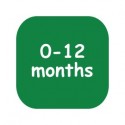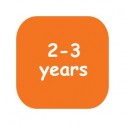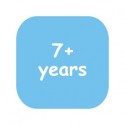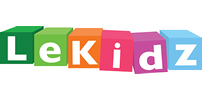When shopping for toys for your children, look for items that are not just age-appropriate and entertaining but also toys that will bolster their development and inspire their imagination and creativity. Children go through various stages of development at different ages. Toys need to stimulate the child’s mind during play.
Some toys are recommended for more than one age category, as children of different ages often enjoy the same toy, each playing with it at his or her own level.
When shopping for toys for your children, look for items that are not just age-appropriate and entertaining but also toys that will bolster their development and inspire their imagination and creativity. Children go through various stages of development at different ages. Toys need to stimulate the child’s mind during play.
Some toys are recommended for more than one age category, as children of different ages often enjoy the same toy, each playing with it at his or her own level.
By Age There are no products in this category.
Subcategories
-
0 - 12 months
For the first three months, your baby isn't able to do much more than observe his/her surroundings. Because his/her vision is still blurry, she sees bright, boldly patterned items best. As your baby grows, she'll enjoy toys that engage her other senses as well. That's why so many toys are designed to promote interaction in a variety of ways: They may make a squeaking or crinkling noise, have a nubby texture, and be soft and cuddly. Infants tend to mouth toys, and textured ones can help relieve teething pain.
-
12 - 24 months
Your baby is fascinated by cause and effect and will enjoy any toy that responds to his actions and makes use of newly acquired motor skills. For instance, he'll love toys that allow him to hit a ball with a hammer as well as toys with buttons that cause music to play or characters to pop up. Some high-tech toys for this age will name a letter, a shape, or a number when your baby presses a button. He's too young to actually learn his ABCs, but he'll still enjoy interacting with these toys and being exposed to language.
Top Toys:
- Stacking rings
- Nesting cups or boxes
- Push- or pull-toys that make noise or have pieces that pop up or move
- Hammering sets that let kids hammer pegs or balls through holes
- Simple, sturdy musical instruments like tambourines, drums, or maracas
- Shape sorters
- Large play vehicles, such as a school bus or a fire engine, plus plastic people that ride in them
- Puzzles with four or five pieces
- Rubber ducks or toy boats for bathtime
-
2 - 3 years
Your child's play is now more purposeful, and she has the fine motor skills needed to complete a puzzle or build with blocks by herself. She'll start to enjoy pretend play that imitates the actions of people around her. She'll like high-tech toys that make real-life sounds, such as telephones that ring or dolls that talk. No matter how politically correct you are, your child will probably play in a gender-stereotypical way -- at least some of the time. A boy may use his dump truck to scoop up sand, while a girl might pretend to feed her doll and put it down for a nap. Boys and girls are both very active at this age and will still enjoy their push- and pull-toys. You can also introduce a ride-on toy: Start with one that your child can propel with both feet, and move up to a tricycle.
Top Toys:
- Dolls and stuffed animals
- Props for make-believe play, such as toy telephone, a tea-party set, a toy kitchen, or a doll stroller
- Ride-on toys and tricycles
- Musical instruments (especially popular are those with flashing lights on the keys that your child needs to press in order to play a tune)
- Large transportation toys with buttons to make a horn honk or a siren whistle
- Puzzles
- Construction toys that snap together
-
3 - 5 years
There's a tremendous explosion in learning ability at this age, and it's a good time to introduce interactive educational toys that teach math and verbal skills, such as phonics boards or mini computers. "Choose toys that say positive things like 'Good job. Let's try again' instead of ones that make negative beeping noises whenever kids get an answer wrong". Kids are now able to imagine that they're someone else and may fantasize about being airplane pilots, police officers, doctors, or teachers. It is also time to introduce shapes, colors, numbers and alphabets toys.
Top Toys:
- Art supplies and craft kits
- Blocks of different shapes
- Electronic phonics toys
- Construction sets with large pieces, such as Legos
- Puzzles of greater complexity
- Action figures
- Barbies
- Dress-up clothes
- Transportation toys, such as parking garages, airports, and train stations
- Board games that don't require reading
- Soccer balls and basketballs
- Bicycles with training wheels
-
5 - 7 years
Your child is developing his own interests while learning from both his teachers and peers. Some kids like doing science experiments (with your help); others love making beaded jewelry or playing with dolls. Friends are becoming increasingly important, and your child will start asking for a particular toy (if he hasn't already) because "everyone else has it." This is the age when kids often become huge fans of computer games, but they also enjoy having their friends over to play sports, card games, and board games. Many like music-related toys, but the playing of actual instruments can still be difficult.
Top Toys:
- Remote-control cars
- Basic science kits
- Magnets, magnifying glasses, and telescopes
- Craft kits
- Barbies
- Game Boys
- Computer and video games
- Construction sets, such as Legos
- Sports equipment
- Board games that involve strategy, including chess and checkers
-
7+ years
Kids this age enjoy outdoor sports as well as scooters, bicycles, and in-line skates. They acquire adult-like interests, abilities, and hobbies and may display a passion by becoming a collector. Girls still love doing crafts and writing in diaries, and boys find computer and video games irresistible. "These years are all about doing things that give kids a sense of mastery and competence". "With computer and video games, kids can challenge themselves to get a better score than they did the time before," she says. "They enjoy competing with their friends, and you'll hear a lot of 'I got this score -- what score did you get?' " Kids also like working on longer projects, some of which might take days to complete.
Top Toys:
- Computer and video games
- Craft kits
- More elaborate science kits
- Outdoor sporting equipment
- Intricate construction sets
- Board games like Scrabble, Monopoly, and Trivial Pursuit Junior
- Model kits







